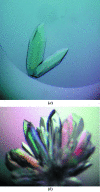Crystallization and preliminary X-ray analysis of PH1010 from Pyrococcus horikoshii OT3, a member of the archaeal DUF54 family of proteins
- PMID: 17554180
- PMCID: PMC2335084
- DOI: 10.1107/S1744309107024487
Crystallization and preliminary X-ray analysis of PH1010 from Pyrococcus horikoshii OT3, a member of the archaeal DUF54 family of proteins
Abstract
PH1010 from Pyrococcus horikoshii OT3, a member of the archaeal DUF54 family of proteins, was expressed, purified and crystallized. Crystallization was performed by the sitting-drop vapour-diffusion method using PEG 3350 as the precipitant. The crystal diffracted X-rays to 1.90 A resolution using a synchrotron-radiation source. The space group of the crystal was determined to be P2(1)2(1)2(1), with unit-cell parameters a = 46.9, b = 49.5, c = 132.7 A. The crystal contained two PH1010 molecules in the asymmetric unit (V(M) = 2.4 A(3) Da(-1)) and had a solvent content of 48%.
Figures



Similar articles
-
Crystallization and preliminary X-ray analysis of PH1566, a putative ribosomal RNA-processing factor from the hyperthermophilic archaeon Pyrococcus horikoshii OT3.Acta Crystallogr Sect F Struct Biol Cryst Commun. 2006 Jan 1;62(Pt 1):47-8. doi: 10.1107/S1744309105040613. Epub 2005 Dec 16. Acta Crystallogr Sect F Struct Biol Cryst Commun. 2006. PMID: 16511260 Free PMC article.
-
Expression, purification, crystallization and preliminary X-ray analysis of the KaiC-like protein PH0187 from the hyperthermophilic archaeon Pyrococcus horikoshii OT3.Acta Crystallogr Sect F Struct Biol Cryst Commun. 2011 Jan 1;67(Pt 1):144-6. doi: 10.1107/S1744309110048426. Epub 2010 Dec 24. Acta Crystallogr Sect F Struct Biol Cryst Commun. 2011. PMID: 21206047 Free PMC article.
-
Crystal structure of the DUF54 family protein PH1010 from hyperthermophilic archaea Pyrococcus horikoshii OT3.Proteins. 2009 Jan;74(1):256-60. doi: 10.1002/prot.22255. Proteins. 2009. PMID: 18831045 No abstract available.
-
Purification, crystallization and preliminary crystallographic analysis of archaeal 6-pyruvoyl tetrahydrobiopterin synthase homologue PH0634 from Pyrococcus horikoshii OT3.Acta Crystallogr Sect F Struct Biol Cryst Commun. 2007 Jan 1;63(Pt 1):15-7. doi: 10.1107/S1744309106051578. Epub 2006 Dec 16. Acta Crystallogr Sect F Struct Biol Cryst Commun. 2007. PMID: 17183164 Free PMC article.
-
Cloning, expression, purification, crystallization and preliminary crystallographic analysis of selenomethionine-labelled KaiC-like protein PH0186 from Pyrococcus horikoshii OT3.Acta Crystallogr Sect F Struct Biol Cryst Commun. 2007 Apr 1;63(Pt 4):327-9. doi: 10.1107/S1744309107011402. Epub 2007 Mar 30. Acta Crystallogr Sect F Struct Biol Cryst Commun. 2007. PMID: 17401208 Free PMC article.
References
-
- Bricogne, G., Vonrhein, C., Flensburg, C., Schiltz, M. & Paciorek, W. (2003). Acta Cryst. D59, 2023–2030. - PubMed
-
- Cohen, G. N., Barbe, V., Flament, D., Galperin, M., Heilig, R., Lecompte, O., Poch, O., Prieur, D., Querellou, J., Ripp, R., Thierry, J. C., Van der Oost, J., Weissenbach, J., Zivanovic, Y. & Forterre, P. (2003). Mol. Microbiol.47, 1495–1512. - PubMed
-
- Kawarabayasi, Y. et al. (1998). DNA Res.5, 55–76. - PubMed
Publication types
MeSH terms
Substances
LinkOut - more resources
Full Text Sources

